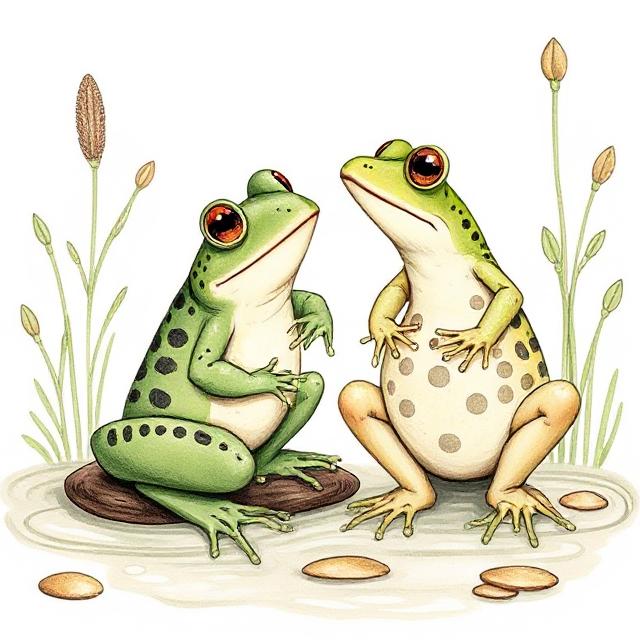Introduction to Frog and Toad Illustrations
Frog and toad illustrations have long captivated artists, children, and nature enthusiasts alike. These charming creatures, with their vibrant colors, unique textures, and expressive poses, serve as a rich source of inspiration for visual storytelling and artistic expression. From classic children’s books to contemporary art, illustrations featuring frogs and toads evoke a sense of whimsy, curiosity, and a deep appreciation for the natural world.
Historical Context of Frog and Toad Illustrations
The depiction of frogs and toads in art dates back centuries, rooted in both mythology and natural observation. In ancient cultures, frogs often symbolized fertility, transformation, and renewal. For example, in Egyptian mythology, the frog was associated with the goddess Heqet, a symbol of fertility and rebirth. Artistic representations from this era often included stylized frogs, emphasizing their symbolic significance.
In Western art history, frogs and toads appeared in medieval illuminated manuscripts, often as humorous or allegorical figures. However, it was in the 19th and 20th centuries that illustrations of these amphibians truly flourished, especially within children’s literature. Artists like Beatrix Potter and Arthur Rackham incorporated frogs and toads into their enchanting illustrations, bringing these creatures to life with meticulous detail and expressive personality.
Frog and Toad in Children’s Literature
Few figures have captured the imaginations of children as effectively as the frogs and toads in classic stories. The beloved characters of Frog and Toad, created by Arnold Lobel, are iconic examples of how illustrations can breathe personality into amphibians. Lobel’s simple yet expressive line art highlights the endearing qualities of these characters—curiosity, friendship, and humor.
In these illustrations, frogs and toads are anthropomorphized, wearing clothes, engaging in human activities, and conveying complex emotions through subtle facial expressions and body language. This approach makes the animals relatable and endearing, fostering a sense of connection and empathy in young readers.
Artistic Techniques in Frog and Toad Illustrations
Artists employ a variety of techniques to depict frogs and toads, each bringing a different mood and style to their work. Some favor realistic portrayals, emphasizing accurate anatomy, textures, and coloration. These illustrations often use watercolor or colored pencil techniques to capture the glossy skin, the moistness of the frog’s eye, or the roughness of a toad’s warty skin.
Others opt for a more stylized or whimsical approach, using bold lines, exaggerated features, or vibrant colors to emphasize personality and humor. Cartoonish representations often appear in comic strips, children’s books, and educational materials, making the creatures approachable and fun.
The setting also plays a crucial role. Illustrations might depict frogs and toads in lush ponds, lily pads, or muddy burrows. These backgrounds not only establish the habitat but also add richness and context to the characters, emphasizing their connection to nature.
Symbolism and Cultural Significance
Frogs and toads in illustrations often carry symbolic meanings. Their metamorphic life cycle—egg, tadpole, adult—serves as a metaphor for transformation and growth. Artists frequently use this symbolism to explore themes of change, renewal, and hope.
In many cultures, frogs symbolize good luck, prosperity, and harmony with nature. For example, in Chinese culture, the three-legged money frog is a popular talisman depicted in art and illustrations to attract wealth. Similarly, in Japanese folklore, frogs are seen as messengers and symbols of safe travel, inspiring countless illustrations that blend cultural symbolism with artistic creativity.
Modern Trends in Frog and Toad Illustrations
Contemporary artists continue to explore and innovate in the realm of frog and toad illustrations. Digital art has allowed for more detailed and dynamic representations, blending realism with fantasy. Artists experiment with surreal compositions, depicting frogs and toads in fantastical worlds or as part of intricate patterns and designs.
Moreover, eco-awareness has influenced modern illustrations, with many artists emphasizing the importance of amphibian conservation. These artworks often highlight the delicate habitats of frogs and toads, incorporating environmental themes and raising awareness about declining populations due to habitat loss and pollution.
Frog and Toad Illustrations in Popular Culture
Beyond literature, frog and toad illustrations have permeated popular culture through merchandise, animations, and decorative arts. The whimsical designs of Kermit the Frog, created by Jim Henson, exemplify how illustrations can become cultural icons. His expressive face and vibrant green color have made Kermit a staple in pop culture, inspiring countless illustrations, plush toys, and animations.
Similarly, the Toad character from the Mario franchise showcases how illustrative design can create memorable, beloved characters that resonate across generations. These characters often feature exaggerated features and expressive faces, making them instantly recognizable and endearing.
The Artistic Value of Frog and Toad Illustrations
Frog and toad illustrations are valued not only for their aesthetic appeal but also for their capacity to bridge the natural and artistic worlds. Artists find inspiration in their behaviors, habitats, and symbolism, translating these into works that inspire wonder and curiosity.
For collectors and enthusiasts, original frog and toad illustrations—whether sketches, watercolor paintings, or digital art—are treasured for their charm and craftsmanship. Many artists also create educational illustrations to teach children about amphibians, blending artistic skill with scientific accuracy.
Conclusion
Frog and toad illustrations continue to enchant audiences worldwide, serving as a testament to the enduring allure of these amphibians. Through various artistic styles—from realistic portrayals to whimsical cartoons—artists celebrate their unique beauty, cultural symbolism, and the vital role they play in ecosystems. As environmental awareness grows, contemporary illustrations increasingly highlight the importance of conserving these remarkable creatures and their habitats. Whether in children’s books, fine art, or popular culture, frogs and toads remain a vibrant and inspiring subject for illustrators, inviting viewers to explore the fascinating world of amphibians through the lens of art.



